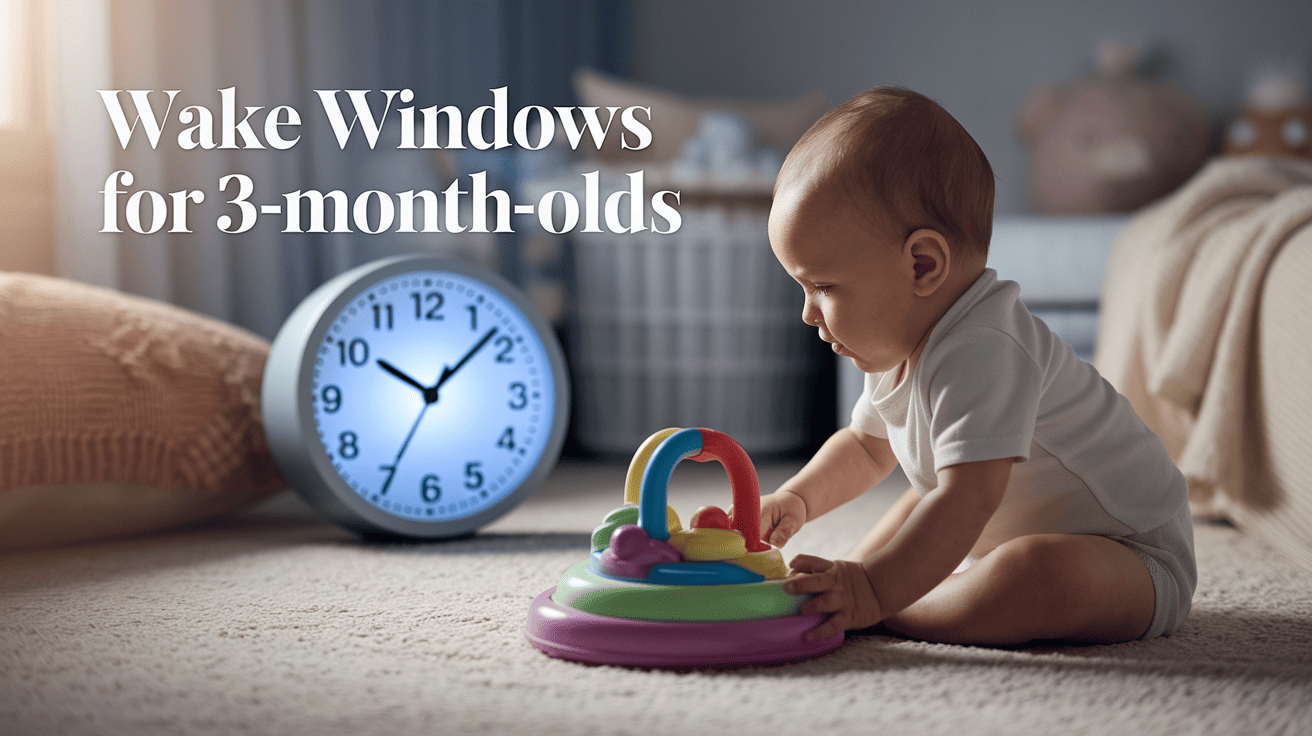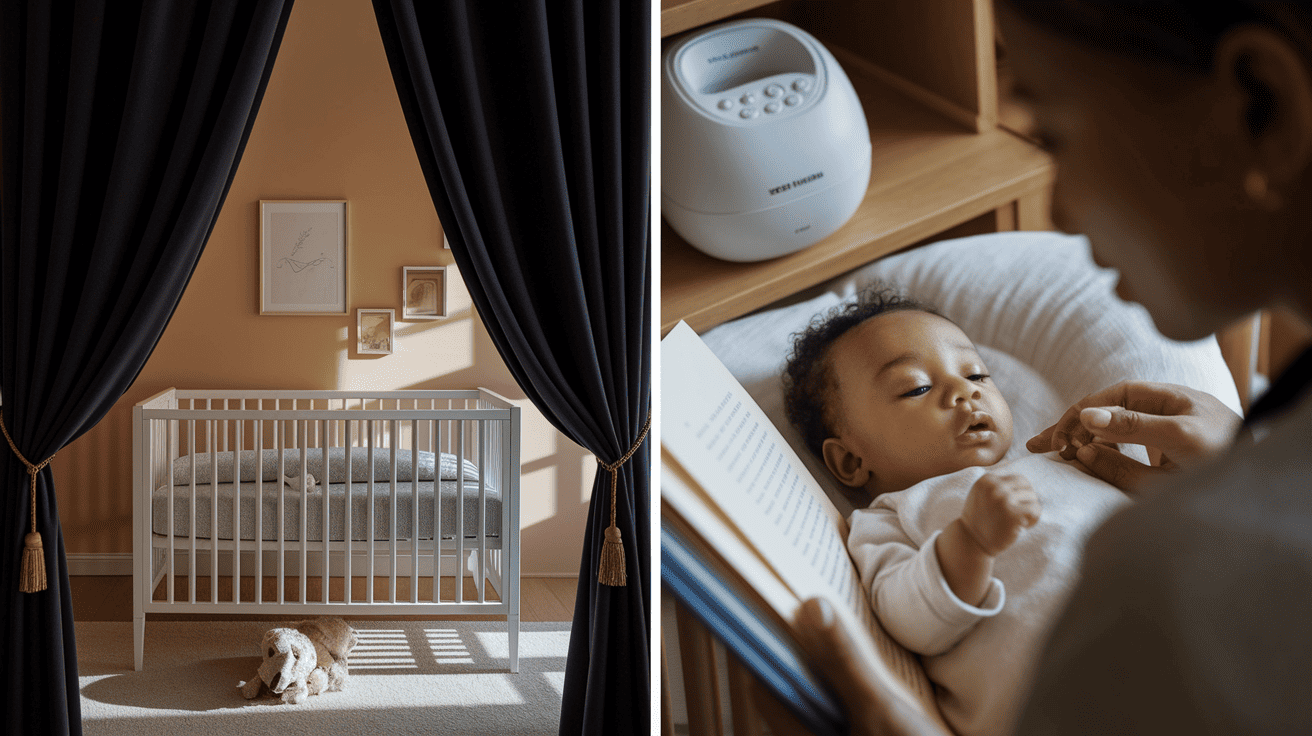
Are you wondering how long are wake windows for a 3-month-old? If your baby seems fussy for no reason or fights naps despite being clearly tired, wake windows might be the missing piece of your baby’s sleep puzzle.
These crucial periods—typically just 60-90 minutes for a 3-month-old—hold the key to better naps, more peaceful nights, and a happier baby. Think of wake windows as your baby’s internal timer, counting down to when their growing brain needs rest again.
Master this gentle rhythm, and you’ll turn chaotic days into predictable routines, catching your baby’s “I’m tired” signals before the meltdowns begin.
What are Wake Windows?
Wake windows are the periods a baby stays awake between sleep sessions. These timeframes represent how long your baby can comfortably remain awake before needing to rest again.
For new parents, understanding wake windows is like finding a helpful guide to your baby’s behavior. When you know your 3-month-old can only handle about 60-90 minutes of awake time, you can anticipate their needs before the fussiness begins.
These windows directly impact your baby’s overall sleep quality and mood—respecting them often leads to better naps, more restful nighttime sleep, and a happier baby.
Keeping track of wake windows helps establish predictable daily routines, which babies do well with.
By watching for sleepy cues like eye rubbing or yawning, you’ll learn to recognize when your baby is approaching the end of their wake window, making the path to naptime smoother for everyone.
Wake Windows for a 3-Month-Old

At 3 months old, most babies can stay awake for about 45 minutes to 1.5 hours between naps. This window is much shorter than what older babies need, as your baby’s brain is still developing and processing lots of new information, which can be tiring.
Every baby is unique, though, and several factors can affect how long your 3-month-old stays awake. Your baby’s natural personality plays a big role—some babies are naturally more alert, while others need more sleep.
Developmental changes also impact wake windows; for example, babies working on new skills like rolling over might tire more quickly.
The time of day matters, too, with morning wake windows often being shorter than afternoon ones. Your baby’s individual needs might shift day to day based on how well they slept the night before, whether they’re going through a growth spurt, or whether they’re not feeling well.
How to Find the Right Wake Window for Your Baby?

Finding the right wake window for your 3-month-old means watching for sleepy signals.
Your baby will show clear signs when it’s ready for a nap, including rubbing its eyes, yawning, looking away from toys or people, becoming less active, or getting fussy.
The key is to put your baby down for a nap at the first signs of tiredness, before they become overtired. Overtired babies often fight sleep even though they need it badly.
To avoid overstimulation, keep activities calm as you approach the end of a wake window—dim the lights, speak softly, and move to a quiet space.
Learning your baby’s patterns takes time, so don’t worry if you miss the window occasionally. Start by tracking when your baby wakes up and shows signs.
After a few days, you’ll notice patterns forming. Remember that these windows may change as your baby grows or during developmental leaps, so stay flexible and adjust based on what you observe.
The Importance of a Consistent Routine

Babies do best with regular, predictable schedules, and sleep is no exception. Creating a consistent routine helps your 3-month-old develop healthy sleep habits that can last for years.
When you follow appropriate wake windows and put your baby down for naps at similar times each day, their body begins to expect and prepare for sleep naturally. This biological rhythm makes it easier for them to fall asleep and stay asleep longer.
Wake windows form the building blocks of this routine—they give structure to your day and help your baby know what to expect next. A baby who naps well during the day often sleeps better at night, too, as they’re less likely to be overtired at bedtime. Consistency doesn’t mean rigidity, though.
It’s still important to read your baby’s cues and make small adjustments when needed. Over time, a predictable sleep schedule built around appropriate wake windows helps everyone in the family know what to expect each day.
Common Mistakes to Avoid with Wake Windows
Many parents struggle to recognize when their baby needs sleep. It’s easy to miss the signs that your baby is tired. Following age-appropriate wake windows helps avoid many sleep issues.
Babies who stay awake too long often sleep worse. Making small adjustments based on your baby’s needs leads to better sleep. Learning from common wake window mistakes can help your whole family rest better.
- Overtiredness is the #1 baby sleep mistake – watch for early signs like quietness
- Babies often seem energetic when exhausted, which confuses parents
- Typical wake windows are 60-90 minutes for young babies
- Growth spurts and developmental leaps temporarily shorten wake windows
- Consistent routines matter more than perfect timing for healthy sleep habits
How do Wake Windows Change Over Time?
Your baby’s ability to stay awake grows steadily in their first year. Newborns can only handle 30-45 minutes of wake time before needing sleep again. By 3 months, this stretches to 1-1.5 hours between naps.
The pattern continues as they grow—
| AGE | TYPICAL WAKE WINDOW | WHAT IT MEANS |
|---|---|---|
| Newborn (0–2 months) | 30–45 minutes | Babies tire quickly and need frequent naps. |
| 3 months | 1–1.5 hours | Wake time increases, but babies still need regular naps. |
| 4 months | 1.5–2 hours | Brain development allows for longer awake periods. |
| 6 months | 2–3 hours | The baby handles more stimulation before getting tired. |
| 12 months | 3–4 hours | Most toddlers manage longer wake windows before needing rest. |
These changes happen because your baby’s brain is maturing and can handle more stimulation before needing rest.
Paying attention to these changing needs is crucial for good sleep. Wake windows that are too short lead to short naps and night-wakings, while windows that are too long cause overtiredness and sleep resistance.
The best approach is to watch both the clock and your baby. When you notice your baby fighting naps or taking longer to fall asleep, it might be time to extend their wake windows slightly.
Tips for Creating the Sleep Environment for Your 3-Month-Old

Babies sleep best in spaces designed for rest. Your 3-month-old needs the right environment to sleep well. Small changes to your baby’s room can make a big difference in their sleep quality.
Setting up the perfect sleep space helps your baby understand it’s time to rest. A consistent bedtime routine signals to your baby that sleep time is coming.
- Keep the room dark with blackout curtains or shades to help your baby recognize it’s sleep time.
- Use white noise to block household sounds and mimic the comforting noise of the womb.
- Maintain a cool room temperature between 68-72°F (20-22°C) for safe, comfortable sleep.
- Dress your baby in breathable, comfortable clothing without too many layers.
- Create a short, calming routine with activities like a warm bath, a gentle massage, or a quiet book.
- Keep the routine consistent and under 20-30 minutes to avoid over-tiring your baby.
Summing It Up
Understanding how long wake windows for a 3-month-old should be—typically 60-90 minutes—gives you a powerful tool in your parenting toolkit.
Remember that these windows will naturally lengthen as your baby grows, but it is always most important to pay attention to their unique tired signals.
By respecting your baby’s need for regular rest periods, you’re not just solving today’s sleep challenges but building healthy sleep habits that will benefit your family for years to come. Keep your sleep environment calm, your routine consistent, and your expectations realistic.
Some days won’t go according to plan, and that’s perfectly normal. With patience and observation, you’ll become an expert at reading your baby’s sleep cues, making naptime smoother and your days more enjoyable.
If you’re interested in more informational content on mothers and babies, feel free to click here and explore other blogs that you might enjoy.

